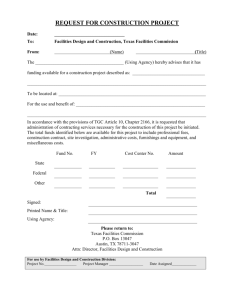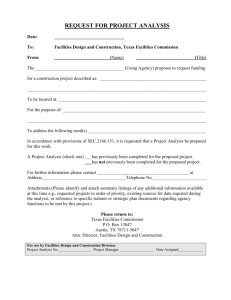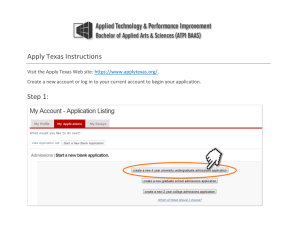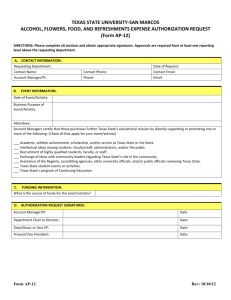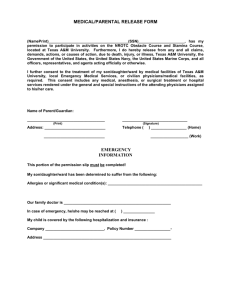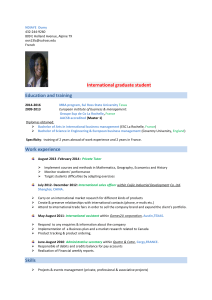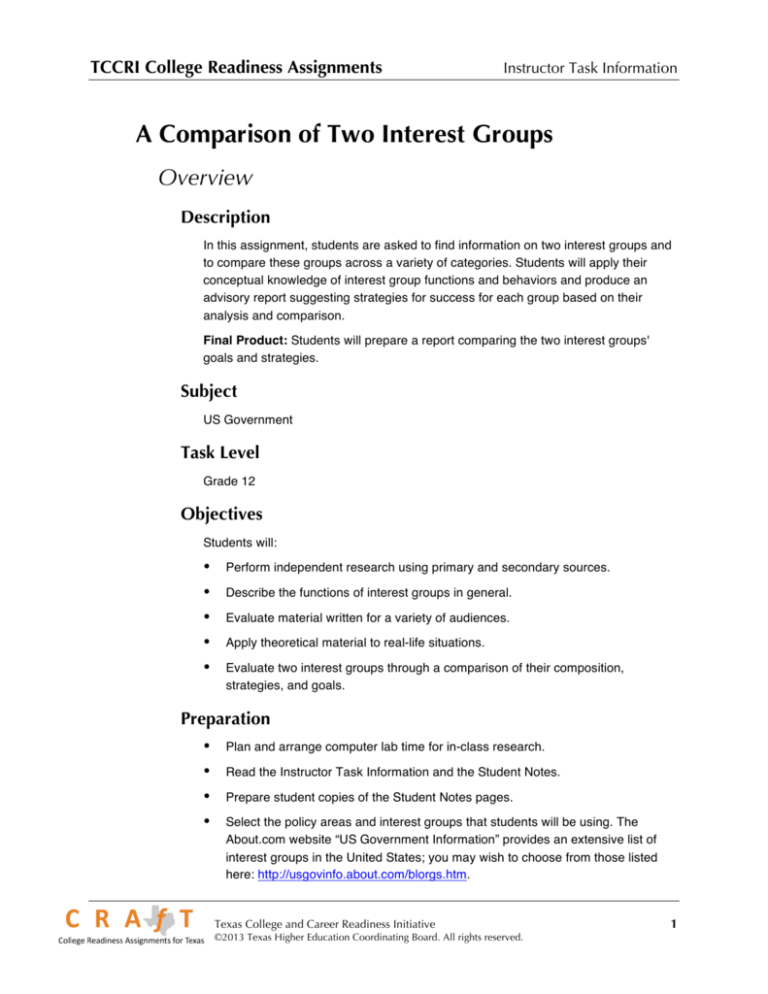
TCCRI College Readiness Assignments
Instructor Task Information
A Comparison of Two Interest Groups
Overview
Description
In this assignment, students are asked to find information on two interest groups and
to compare these groups across a variety of categories. Students will apply their
conceptual knowledge of interest group functions and behaviors and produce an
advisory report suggesting strategies for success for each group based on their
analysis and comparison.
Final Product: Students will prepare a report comparing the two interest groups'
goals and strategies.
Subject
US Government
Task Level
Grade 12
Objectives
Students will:
•
Perform independent research using primary and secondary sources.
•
Describe the functions of interest groups in general.
•
Evaluate material written for a variety of audiences.
•
Apply theoretical material to real-life situations.
•
Evaluate two interest groups through a comparison of their composition,
strategies, and goals.
Preparation
•
Plan and arrange computer lab time for in-class research.
•
Read the Instructor Task Information and the Student Notes.
•
Prepare student copies of the Student Notes pages.
•
Select the policy areas and interest groups that students will be using. The
About.com website “US Government Information” provides an extensive list of
interest groups in the United States; you may wish to choose from those listed
here: http://usgovinfo.about.com/blorgs.htm.
Texas College and Career Readiness Initiative
©2013 Texas Higher Education Coordinating Board. All rights reserved.
1
A Comparison of Two Interest Groups
Instructor Task Information
or
Visit the Texas Ethics Commission website at http://www.ethics.state.tx.us/ to
determine which of these groups are registered and active in Texas.
•
Prepare samples of different promotional materials for local interest groups
(brochures, flyers, etc.). Be ready to lead a discussion on their creation, purpose,
and effectiveness.
•
You may decide to allow students to choose their own groups, with your
approval. In that case, refer them to the websites above.
•
There are many possible ways to pair interest groups: two groups advocating for
similar interests; two groups advocating for opposing interests; an economic
interest group and a government interest group; a group with a large membership
and one with very small membership; and so on.
•
Familiarize yourself with the websites of the various interest groups to be used.
You may wish to develop a sheet of these listings as a handout for students if
you decide to allow them to choose the interest groups they are comparing.
•
Determine information to be collected on each group.
Prior Knowledge
Students need to know how to do research on the Internet. They need to be able to
write a report.
Key Concepts and Terms
•
Grassroots
•
Propaganda
•
Interest group
•
Single-issue group
•
Lobbying
•
Special interests
Time Frame
This assignment will require approximately one to two hours of class time and two
weeks of out-of-class time for writing the report. If necessary, additional time can be
added to demonstrate research skills and information to be collected by each group.
Add additional time for research if students do not have access to computers outside
of school.
Allow one to two class periods to introduce the topic and facilitate discussion. Allow
one week for research (or more if students must access computers at school) and
one week for writing the report. If time permits, allow a final class period for students
to share information about some of the more interesting interest groups they studied.
This assignment can be modified to meet the needs of different classroom schedules
and student ability levels.
Texas College and Career Readiness Initiative
©2013 Texas Higher Education Coordinating Board. All rights reserved.
2
A Comparison of Two Interest Groups
Instructor Task Information
Instructional Plan
Getting Started
Learning Objectives
Students will:
•
Participate in a class discussion about interest groups.
•
Compare the goals of two interest groups.
•
Define the term interest group.
Procedure
1. Write the names of two extremely diverse interest groups on the board; for
example, the National Rifle Association (NRA) and the Sierra Club. Ask
students what each of these groups advocates for. Ask what they have in
common.
2. Discuss what an interest group is. Have the class agree upon a definition.
Tell students that interest groups have a variety of foci: economic interest,
citizens’ group, government interest, foreign policy, nationality, religious
organizations, and more. Point out that the two interest groups named on the
board are both citizens’ groups.
3. Examine the promotional materials of local interest groups. Show the
students how these groups present themselves with direct mail pieces or
press releases. Discuss the purpose, structure, and effectiveness of the
promotional impact.
4. Introduce the assignment to students. Make sure that they understand that
the assignment is an analysis and should include both comparisons and
recommendations.
Investigating
Learning Objectives
Students will:
•
Perform independent research using primary and secondary sources.
•
Maintain accurate research notes on the content of sources.
•
Evaluate material written for a variety of audiences and purposes.
Procedure
1. Either assign two interest groups to each student, or allow them to select two
groups that interest them and that they think would provide a good
Texas College and Career Readiness Initiative
©2013 Texas Higher Education Coordinating Board. All rights reserved.
3
A Comparison of Two Interest Groups
Instructor Task Information
comparison. If you choose the latter option, make sure students obtain your
approval for their choices.
Have students do research to find information on the goals and objectives of
the groups they have identified or been assigned. Encourage students to
telephone the interest group’s office if they want more information than is
available on the group’s website. They should print off this material and make
note of the exact source, as they will need to cite it in their final report.
Remind students to pay attention to the groups’ membership and missions or
goals as well as activities.
2. Have students also find information on the group's recent successes (or
failures) in accomplishing their goals and determine the strategies the groups
used. For this component, students should extend their research beyond the
interest groups’ websites for more objective information.
3. Then, students should look at the websites for the United States Congress,
office of the presidency, and United States federal agencies to identify the
offices and individuals with whom the groups should seek to work to
accomplish their goals.
or
Then, students should look at the websites for the Texas Legislature, Texas
State Agencies, and the office of the governor to identify the offices and
individuals with whom the groups should seek to work in order to accomplish
their goals.
4. Once students have completed their research, have them review their
sources to decide what will be used in their report and where they might fit.
Drawing Conclusions
Learning Objectives
Students will:
•
Synthesize their research into a written comparison of interest groups.
•
Write a recommendation at the close of their report to each group on ways to
be more successful.
•
Do a peer review of another student’s report.
•
Write a final draft, incorporating feedback from a peer review.
Procedure
1. Have students prepare a report comparing the interest groups' goals and
strategies. The report should deal with both similarities and differences.
2. After this comparison, students should apply their theoretical knowledge of
interest group behavior and strategies by evaluating the existing tools used
by the groups to accomplish their goals. They should then make
Texas College and Career Readiness Initiative
©2013 Texas Higher Education Coordinating Board. All rights reserved.
4
A Comparison of Two Interest Groups
Instructor Task Information
recommendations as to whether each group should continue existing
strategies, add new strategies (and, if so, indicate how), or change to
different strategies. In these recommendations they should indicate with
whom in the federal government the groups should work and how to
accomplish the organizational goals.
3. Have students exchange reports with a partner for a peer review and
incorporate this feedback into a final draft. Collect both the rough draft and
documentation of the peer review with the final draft.
4. If time permits before students submit their final reports, invite students to
share with the class information about the interest groups they have
researched.
5. Complete the activity with the discussion of how interests group apply to their
school. What are some examples of helpful interest groups? What purposes
might they serve? What should students hope to accomplish with each
group? How might the students begin an interest group?
Texas College and Career Readiness Initiative
©2013 Texas Higher Education Coordinating Board. All rights reserved.
5
A Comparison of Two Interest Groups
Instructor Task Information
Scaffolding/Instructional Support
The goal of scaffolding is to provide support to encourage student success,
independence, and self-management. Instructors can use these suggestions, in part or
all together, to meet diverse student needs. The more skilled the student, however, the
less scaffolding that he or she will need. Some examples of scaffolding that could apply
to this assignment include:
•
Produce and provide graphic organizers to help students visualize the interest group
process, including the relationships among groups.
•
Offer guided tutoring when necessary.
•
Practice researching in class on websites not assigned to a group.
•
Develop student task cards specifically stating what information should be collected
on the groups.
•
Check students’ progress frequently throughout the Investigating and Drawing
Conclusions phases. Provide additional support for students who are having difficulty
completing their reports.
Texas College and Career Readiness Initiative
©2013 Texas Higher Education Coordinating Board. All rights reserved.
6
A Comparison of Two Interest Groups
Instructor Task Information
Solutions
The information below is intended to help you assess students’ final work products. It
may not represent all possible strategies and ideas. The accompanying scoring guide
provides specific examples of ways a student might demonstrate content understanding
and mastery of cross-disciplinary skills.
Necessary Elements
Students should identify what they know about interest groups, compare it with other
students’ knowledge, and develop a definition of interest groups based on prior
knowledge and information gleaned from class discussion.
Students should identify appropriate and sufficient sources for research, including
locating the websites of the interest groups they are studying as well as various
government websites that are likely to provide insight into the nature of the groups’ work.
Students should use appropriate methods to keep track of information gathered from
source material, and evaluate evidence for quality and quantity. Any data sources used
should be cited accurately and a Works Cited page should be included.
Students’ reports should present thorough comparisons of the two interest groups,
covering both similarities and differences.
Key Connections
Students should contribute thoughtfully to the class discussion: key points, insights, and
questions about interest groups.
Students should demonstrate adequate recognition of the scope of the complex topic,
examining interest groups’ missions, goals, and activities, and then applying knowledge
of interest groups to make relevant recommendations for improvement to the groups’
strategies.
Students’ reports should transition smoothly from comparison to recommendations. The
recommendations should be based on evidence and students’ understanding of the
functioning of interest groups.
Common Misconceptions
Personal opinions do not constitute sufficient evidence for assertions and conclusions. All
descriptions and assertions about interest groups should be supported by reliable
evidence.
Texas College and Career Readiness Initiative
©2013 Texas Higher Education Coordinating Board. All rights reserved.
7
A Comparison of Two Interest Groups
Instructor Task Information
TCCRS Cross-Disciplinary Standards Addressed
Performance Expectation
Getting
Started
Investigating
Drawing
Conclusions
I. Key Cognitive Skills
A.1. Engage in scholarly inquiry and dialogue.
A.2. Accept constructive criticism and revise
personal views when valid evidence warrants.
P
P
P
P
B.2. Construct well-reasoned arguments to explain
phenomena, validate conjectures, or support
positions.
P
B.3. Gather evidence to support arguments,
findings, or lines of reasoning.
P
C.1. Analyze a situation to identify a problem to be
solved.
P
C.2. Develop and apply multiple strategies to solve a
problem.
P
D.1. Self-monitor learning needs and seek
assistance when needed.
P
P
P
D.2. Use study habits necessary to manage
academic pursuits and requirements.
P
P
P
D.3. Strive for accuracy and precision.
P
P
P
D.4. Persevere to complete and master tasks.
P
P
P
P
P
E.1. Work independently.
P
E.2. Work collaboratively.
P
F.1. Attribute ideas and information to source
materials and people.
P
F.2. Evaluate sources for quality of content, validity,
credibility, and relevance.
P
F.4. Understand and adhere to ethical codes of
conduct.
P
P
II. Foundational Skills
A.1. Use effective prereading strategies.
A.4. Identify the key information and supporting
details.
A.5. Analyze textual information critically.
P
P
P
Texas College and Career Readiness Initiative
©2013 Texas Higher Education Coordinating Board. All rights reserved.
8
A Comparison of Two Interest Groups
Instructor Task Information
A.6. Annotate, summarize, paraphrase, and outline
texts when appropriate.
P
A.7. Adapt reading strategies according to structure
of texts.
P
B.1. Write clearly and coherently using standard
writing conventions.
P
P
P
B.3. Compose and revise drafts.
P
C.5. Synthesize and organize information effectively.
P
C.6. Design and present an effective product.
P
C.7. Integrate source material.
P
P
E.1. Use technology to gather information.
TCCRS Social Studies Standards Addressed
Performance Expectation
Getting
Started
Investigating
Drawing
Conclusions
I. Interrelated Disciplines and Skills
C.3. Explain and analyze the importance of civic
engagement.
E.1. Identify different social groups (e.g., clubs,
religious organizations) and examine how they
form and how and why they sustain
themselves.
E.3. Analyze how social institutions (e.g., marriage,
family, churches, schools) function and meet
the needs of society.
P
P
P
P
F.1. Use a variety of research and analytical tools to
explore questions or issues thoroughly and
fairly.
P
P
IV. Analysis, Synthesis, and Evaluation of Information
A.1. Identify and analyze the main idea(s) and
point(s) of view in sources.
A.2. Situate an informational source in its
appropriate contexts (contemporary, historical,
cultural).
P
P
Texas College and Career Readiness Initiative
©2013 Texas Higher Education Coordinating Board. All rights reserved.
P
9
A Comparison of Two Interest Groups
A.4. Understand the differences between a primary
and secondary source and use each
appropriately to conduct research and construct
arguments.
Instructor Task Information
P
A.5. Read narrative texts critically.
P
A.6. Read research data critically.
P
B.1. Use established research methodologies.
P
B.3. Gather, organize, and display the results of data
and research.
B.4. Identify and collect sources.
P
P
P
P
D.1. Construct a thesis that is supported by
evidence.
P
V. Effective Communication
A.1. Use appropriate oral communication techniques
depending on the context or nature of the
interaction.
A.2. Use conventions of standard written English.
B.1. Attribute ideas and information to source
materials and authors.
P
P
P
TEKS Standards Addressed
Comparison of Two Interest Groups - Texas Essential Knowledge and Skills (TEKS): Social Studies,
Government
113.44.c.11. Government. The student understands the role of political parties in the U.S. system of
government. The student is expected to:
113.44.c.11.C. identify opportunities for citizens to participate in political party activities at local,
state, and national levels.
113.44.c.13. Citizenship. The student understands rights guaranteed by the U.S. Constitution. The
student is expected to:
113.44.c.13.A. understand the roles of limited government and the rule of law in the protection of
individual rights.
113.44.c.13.B. identify and define the unalienable rights.
113.44.c.13.C. identify the freedoms and rights guaranteed by each amendment in the Bill of
Rights.
113.44.c.13.F. recall the conditions that produced the 14th Amendment and describe subsequent
efforts to selectively extend some of the Bill of Rights to the states, including the Blaine
Amendment and U.S. Supreme Court rulings, and analyze the impact on the scope of
fundamental rights and federalism.
Texas College and Career Readiness Initiative
©2013 Texas Higher Education Coordinating Board. All rights reserved.
10
A Comparison of Two Interest Groups
Instructor Task Information
Comparison of Two Interest Groups - Texas Essential Knowledge and Skills (TEKS): Social Studies,
Government
113.44.c.15. Citizenship. The student understands the importance of voluntary individual participation in
the U.S. constitutional republic. The student is expected to:
113.44.c.15.A. analyze the effectiveness of various methods of participation in the political
process at local, state, and national levels.
113.44.c.15.C. understand the factors that influence an individual's political attitudes and actions.
113.44.c.16. Citizenship. The student understands the importance of the expression of different points of
view in a constitutional republic. The student is expected to:
113.44.c.16.A. examine different points of view of political parties and interest groups such as the
League of United Latin American Citizens (LULAC), the National Rifle Association (NRA), and the
National Association for the Advancement of Colored People (NAACP) on important
contemporary issues.
113.44.c.16.B. analyze the importance of the First Amendment rights of petition, assembly,
speech, and press and the Second Amendment right to keep and bear arms.
113.44.c.20. Social studies skills. The student applies critical-thinking skills to organize and use
information acquired from a variety of valid sources, including electronic technology. The student is
expected to:
113.44.c.20.A. analyze information by sequencing, categorizing, identifying cause-and-effect
relationships, comparing, contrasting, finding the main idea, summarizing, making generalizations
and predictions, and drawing inferences and conclusions.
113.44.c.20.B. create a product on a contemporary government issue or topic using critical
methods of inquiry.
113.44.c.20.D. analyze and evaluate the validity of information, arguments, and
counterarguments from primary and secondary sources for bias, propaganda, point of view, and
frame of reference.
113.44.c.20.F. use appropriate mathematical skills to interpret social studies information such as
maps and graphs.
113.44.c.21. Social studies skills. The student communicates in written, oral, and visual forms. The
student is expected to:
113.44.c.21.A. use social studies terminology correctly.
113.44.c.21.B. use standard grammar, spelling, sentence structure, and punctuation.
113.44.c.21.C. transfer information from one medium to another, including written to visual and
statistical to written or visual, using computer software as appropriate.
113.44.c.21.D. create written, oral, and visual presentations of social studies information.
113.44.c.22. Social studies skills. The student uses problem-solving and decision-making skills, working
independently and with others, in a variety of settings. The student is expected to:
113.44.c.22.A. use a problem-solving process to identify a problem, gather information, list and
consider options, consider advantages and disadvantages, choose and implement a solution,
and evaluate the effectiveness of the solution.
113.44.c.22.B. use a decision-making process to identify a situation that requires a decision,
gather information, identify options, predict consequences, and take action to implement a
decision.
Texas College and Career Readiness Initiative
©2013 Texas Higher Education Coordinating Board. All rights reserved.
11
TCCRI College Readiness Assignments
Student Notes
A Comparison of Two Interest Groups
Introduction
Interest groups have been players in United States politics since our country was
born. In this assignment, you will focus on comparing two interest groups. You
will find information on the groups, evaluate the strategies used to accomplish
their goals, and provide suggestions for their future endeavors. You will write a
final report comparing and contrasting the two groups and then advising each
interest group on what to improve, what to change, and how to better accomplish
their goals.
Directions
Getting Started
1. Discuss what an interest group is. Think about the many different kinds of
interest groups. Come to agreement with your fellow students on a definition
of the term interest group.
2. Take part in the class discussion comparing the two selected interest groups.
What are the different purposes of interest groups? What are some of the
various strategies they use to have influence in the public domain? How are
they alike or different?
3. Examine the promotional materials (direct mail, brochures, press releases,
etc.) of local interest groups. Discuss the purpose, structure, and
effectiveness of the examples provided by your teacher.
4. Listen carefully as your instructor introduces the assignment. Notice the two
components—comparison and recommendation—of the report.
Investigating
1. Your instructor will either assign two interest groups to you, or you will select
two groups that interest you and that you think would provide a good
comparison. If you choose your interest groups, make sure your instructor
approves the choices.
2. Then do research to find information on the goals and objectives of the
groups you have identified or been assigned. You may also want to telephone
an interest group’s office if you want more information than is available on the
group’s website. Print the materials that you think you will need for your
Texas College and Career Readiness Initiative
©2013 Texas Higher Education Coordinating Board. All rights reserved.
S-1
A Comparison of Two Interest Groups
Student Notes
report and make note of the exact sources, as you will need to cite them in
your final report. Pay attention to the groups’ membership and missions or
goals, as well as activities.
2. Find information on the group's recent successes (or failures) in
accomplishing their goals, and determine the strategies the groups used. For
this component, extend your research beyond the interest groups’ websites
for more objective information.
3. Then, look at the websites for the United States Congress, office of the
presidency, and United States federal agencies to identify the offices and
individuals with whom the groups should seek to work in order to accomplish
their goals.
or
Then, look at the websites for the Texas Legislature, Texas State Agencies,
and the office of the governor to identify the offices and individuals with whom
the groups should seek to work in order to accomplish their goals.
4. Once you have completed your research, review your sources to decide what
will be useful in your report and where it might fit.
Drawing Conclusions
1. Prepare a report comparing the interest groups' goals and strategies. The
report should deal with both similarities and differences.
2. After this comparison, apply your knowledge of interest group behavior and
strategies by evaluating the existing tools used by the groups to accomplish
their goals. Then, make recommendations as to whether each group should
continue the existing strategies, add new strategies (and, if so, indicate how),
or change to different strategies. In these recommendations, indicate with
whom in the federal government the groups should work and how to
accomplish the organizational goals.
3. Exchange the rough draft of your report with a partner for a peer review, and
incorporate this feedback into a final draft. Turn in both your rough draft and
documentation of the peer review feedback you received with your report.
4. Participate in a discussion with your classmates about how interest groups
apply to your school. What are some examples of helpful interest groups?
What purposes might they serve? What should these groups hope to
accomplish?
Texas College and Career Readiness Initiative
©2013 Texas Higher Education Coordinating Board. All rights reserved.
S-2

